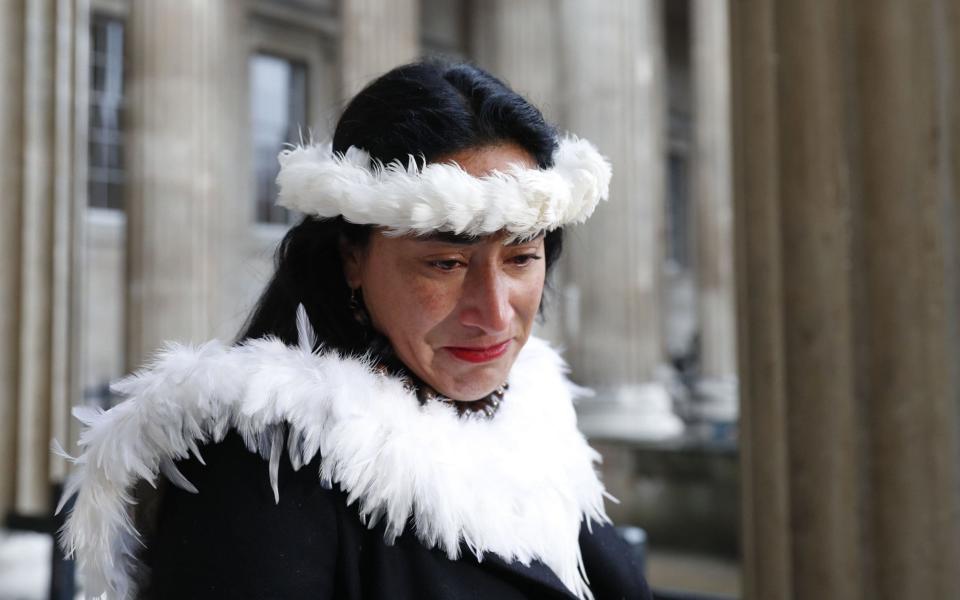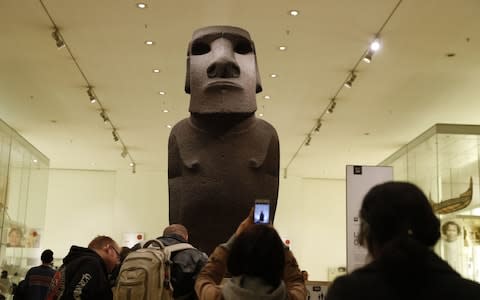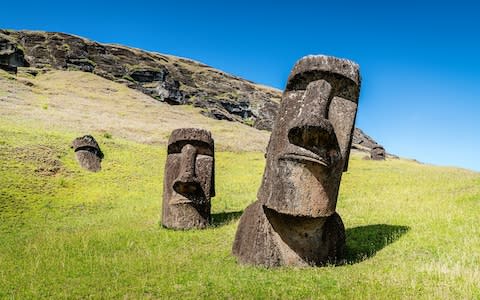Easter Island delegation makes emotional plea for British Museum to return spiritual Moai statue

A delegation from Easter Island arrived at the British Museum on Tuesday to make a plea for the return of their "ancestor and soul".
The indigenous community, known as the Rapa Nui, are requesting that Britain permanently return a spiritually “unique” Moai statue currently on display in the Museum’s Wellcome Trust Gallery.
The Hoa Hakananai'a statue was taken to England from the Chilean island in 1868 by Richard Powell, captain of HMS Topaze, and gifted to Queen Victoria who later gave it to the British Museum.
However now the Rapa Nui people, who believe the sculpture emits a "mana" spiritual force that protects their tribe, are requesting that it is returned.
Making an emotional plea after meeting with the Museum authorities, Tarita Rapu, the Governor of Easter Island, wiped away tears as she said: “My grandma, who passed away almost 90 years ago, never got the chance to see her ancestor. I have been alive for almost half a century and this is my first time seeing him.

“We are just a body. The people of England have our soul.
“You have kept him for 150 years. Thank you all to the beautiful people of this country who have taken care of our grandfather. But give us the chance to have him back.”
Ms Rapu said she “melted with love and gratitude” when she first saw the Hoa Hakananai'a yesterday morning. She was joined by a delegation of a dozen Rapa Nui tribesmen and women who all arrived in London on Monday evening ahead of the meeting.
The 2.4-metre tall sculpture is one of 900 statues on the Island carved from volcanic ash between the sixth and 17th centuries to honour important chiefs when they passed away.
However the British Museum - who are due to visit Easter Island in the coming months for the next stage of negotiations - have said that they are not able to legally return the object under the British Museum Act.
Passed in 1963, the Act stipulates that the 25 Trustees of the Museum - who are appointed by the Queen, the Prime Minister, and the Secretary of State - have the duty to “keep the objects comprised in the collections of the Museum within the authorised repositories of the Museum”.
They are, however, allowed to agree a temporary loan of three to five months, which the Museum yesterday confirmed it was considering in the case of the Moai statue.
“We believe that there is great value in presenting objects from across the world, alongside the stories of other cultures at the British Museum,” a spokeswoman said. “The Museum is one of the world’s leading lenders and the Trustees will always consider loan requests subject to usual conditions.”
Chile’s national treasures minister, Felipe Ward, said the Hoa Hakananai'a is a particularly unique Moai statue and “more than just a stone” to the Rapa Nui population.

Mr Ward said: “I am absolutely sure that [the Museum’s authorities] understood the meaning the Moai statue has for the Rapa Nui people. This is much more than just a stone - and they understood that. That’s why we are really happy with this meeting.
“We understand that this is a very important part of the collection at the British Museum. But this is more important for the people of Rapa Nui than for the authorities and the people here in Great Britain.”
Mr Ward confirmed that the Rapa Nui people have even offered to make another “identical” Moai statue for the British Museum to display in exchange for the Hoa Hakananai'a.
The Department for Culture, Media and Sport said that there are no plans to review legislation of the British Museum Act, which could permit the statue to be returned permanently.
A DCMS spokesman said: “The Moai is the legal property of the British Museum and is viewed free of charge by people from all over the world.
“Decisions relating to its care are taken by the Trustees of the British Museum, free from political interference.”

 Yahoo News
Yahoo News 